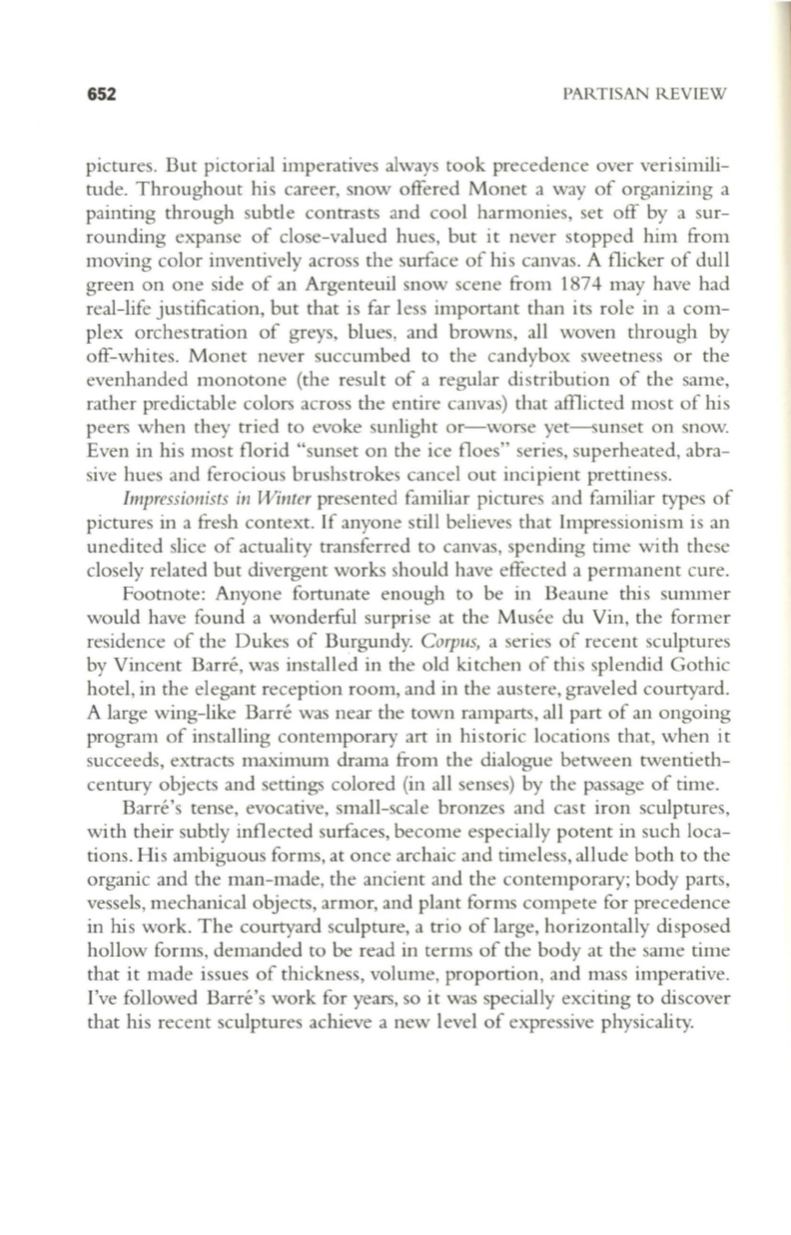
652
PARTISAN REVIEW
pictures. But pictorial imperatives always took precedence over verisimili–
tude. Throughout his career, snow offered Monet a way of organizing a
painting through subtle contrasts and cool harmonies, set off by a sur–
rounding expanse of close-valued hues, but it never stopped him from
moving color inventively across the surface of his canvas. A flicker of dull
green on one side of an Argenteuil snow scene from 1874 may have had
real-life justification, but that is far less important than its role in a com–
plex orchestration of greys, blues, and browns, all woven through by
off-whi tes. Monet never succumbed to the candybox sweetness or the
evenhanded monotone (the result of a regular distribution of the same,
rather predictable colors across the entire canvas) that aillicted most of his
peers when they tried to evoke sunlight or-worse yet-sunset on snow.
Even in his most florid "sunset on the ice floes" series, superheated, abra–
sive hues and ferocious brushstrokes cancel out inci pient prettiness.
Impressionists in Winter
presented familiar pictures and familiar types of
pictures in a fresh context. If anyone still believes that Impressionism is an
unedited slice of actuality transferred
to
canvas, spending time with these
closely related but divergent works should have effected a permanent cure.
Footnote: Anyone fortunate enough to be in Beaune this summer
would have found a wonderful surprise at the Musee du Vin, the former
residence of the Dukes of Burgundy.
Corpus,
a series of recent sculptures
by Vincent Barre, was installed in the old kitchen of this splendid Gothic
hotel, in the elegant reception room, and in the austere, graveled courtyard.
A large wing-like Barre was near the town ramparts, all part of an ongoing
program of installing contemporary art in historic locations that, when it
succeeds, extracts maximum drama from the dialogue between twentieth–
century objects and settings colored (in all senses) by the passage of time.
Barre's tense, evocative, small-scale bronzes and cast iron sculptures,
with their subtly inflected surfaces, become especially potent in such loca–
tions. His ambiguous forms, at once archaic and timeless, allude both to the
organic and the man-made, the ancient and the contemporary; body parts,
vessels, mechanical objects, armor, and plant forms compete for precedence
in his work. The courtyard sculpture, a trio of large, horizontally disposed
hollow forms, demanded to be read in terms of the body at the same time
that it made issues of thickness, volume, proportion, and mass imperative.
I've followed Barre's work for years, so it was specially exciting to discover
that his recent sculptures achieve a new level of expressive physicality.


